
16 11 24 32 Six HR Trends That Will Shape The American Workplace In 2023 - Emily Hann, Leadpages HR Pitfalls To Avoid In 2023 - Naveen Bhateja, Medidata Solutions HR Teams Can Use AI To Decipher And Respond To The Labor Market’s Mixed Signals - Rebecca Jones, Mosaicx JANUARY 2023 • Vol. 11 • No.01 (ISSN 2564-1956) THE FUTURE ROLE OF HR What should HR focus on? How Human Capability Initiatives Deliver Value To All Stakeholders - Dave Ulrich and Norm Smallwood, Ross School of Business and The RBL Group

The Future Role Of HR What should HR focus on? Compiled by the Excellence Publications Team 07 INDEX On the Cover HR Strategy & Planning Excellence JANUARY 2023 Vol.11 No.01 (ISSN 2564-1956) Articles 30 Technology And Workplace Predictions 2023 4 trends which might just defy conventional wisdom - Jeetu Patel, Executive Vice President and General Manager, Security and Collaboration, Cisco 36 Flexibility At Work: The Need Of The Hour Measure productivity by results, not days of the week or hours at a computer - Scott Day, Chief People Officer, Alludo 39 Getting Cost Optimization Right Tips to avoid common mistakes when implementing cost optimization strategies - Nick Shah, CEO and Founder, Peterson Technology Partners 19 A Lack Of Remote Work Options May Be Causing Employee Turnover How HR teams can meet the demand for remote work - Josh Millet, Founder and CEO, Criteria 14 Exclusive Interview: Claire Essex- Crosby, Chief People Officer, Eagle Eye Solutions Ltd. CHRO CORNER
Six HR Trends That Will Shape The American Workplace In 2023

HR professionals should incorporate these trends into their HR strategy
- Emily Hann, Director of People
and Culture, Leadpages
HR Pitfalls To Avoid In 2023


HR can improve the employee experience by prioritizing humancentric approaches to growth
- Naveen Bhateja, Chief People Officer, Medidata Solutions
How Human Capability Initiatives Deliver
Value To All Stakeholders
Governance and guidance for growth through human capability
- Dave Ulrich, Rensis Likert Professor, Ross School of Business and Norm Smallwood, Partner, The RBL Group and G3HC
Top Picks 11 16 24 32
HR Teams Can Use AI To Decipher And Respond To The Labor Market’s Mixed Signals
Businesses can preserve, empower and maximize existing resources and talent by introducing automation - Rebecca Jones, General Manager, Mosaicx

INDEX
How are our HR Strategy & Planning Products and Ser vices helping to make you smar ter?
HR Strategy & Planning Excellence - Monthly Interactive Learning Journal

This monthly interactive learning experience captures key metrics and actionable items and keeps you focused on your HR strategy and planning goals and solutions.
HR Strategy and Planning Vir tual Events

In HR Strategy and Planning events, discover the business process for ensuring that an organization has suitable access to talent to ensure future business success, trends in strategic planning and analytics, resource requests, analyzing resource utilization, forecasting capacity, and managing human resources. The learning experience offered teaches how to capture key metrics and actionable items and keep you focused on your HR strategy and planning goals and solutions and make them impactful. Each Vir tual Event consists of up to 10 credit webcasts.
HR Strategy and Planning Webcasts for Credit
HR.com webcasts deliver the latest HR Strategy and Planning industry news, research trends, best practices and case studies directly to your desktop. Webcasts are available live online with a downloadable podcast and a copy of the slides (PDF) available before and after each
HR.com’s one-hour webcasts, in every HR specialty including HRIS and Payroll, are pre-approved for HRCI and SHRM credit (excluding Demo webcasts).
HR Strategy and Planning Community
Join almost 70,000 HR.com members with a similar interest and focus on workforce planning and analytics. Share content and download reserach repor ts, blogs, and ar ticles, network, and “follow” peers and have them “follow” you in a social network platform to communicate regularly and stay on top of the latest updates. This well established Workforce Planning and Analytics Community is an invaluable resource for any HR professional or manager Use
these invaluable HR Strategy & Planning resources today! For more information phone: 1.877.472.6648 | email: sales@hr.com | www.hr.com
Editorial Purpose
Our mission is to promote personal and professional development based on constructive values, sound ethics, and timeless principles.
Excellence Publications
Debbie McGrath CEO, HR.com - Publisher
Sue Kelley Director (Product, Marketing, and Research)

Babitha Balakrishnan and Deepa Damodaran Excellence Publications Managers and Editors
HR Strategy & Planning Excellence (ISSN 2564-1956)
Babitha Balakrishnan Editor
Arun Kumar R Design and Layout (Digital Magazine)
Vibha Kini Magazine (Online Version)
Submissions & Correspondence
Please send any correspondence, articles, letters to the editor, and requests to reprint, republish, or excerpt articles to ePubEditors@hr.com
For customer service, or information on products and services, call 1-877-472-6648
Debbie Mcgrath Publisher, HR.com
Babitha Balakrishnan Editor, HR Strategy & Planning Excellence

The New Role of HR in the Future of Work
TheCovid-19 pandemic blurred the lines between work and life like never before. Businesses are trying to make sense of what work looks like now. Employees are stressed and are trying to figure out ways to prioritize their lives and work where they feel most productive. And in between is HR! HR is entrusted with the core task of effectively balancing the needs of the company with the changing needs of the employees and making a win-win situation out of both.
As we look ahead to 2023, this year will witness new trends adding value to the recent transformation that the HR industry has experienced. And to survive in today’s ever-evolving landscape, HR has to keep up with the new skills and knowledge. What types of HR roles are going to be in demand moving forward?
According to experts, there will be a rise in HR roles prioritizing AI, cybersecurity, and compliance. An increase in the number of HR professionals devoted to leadership development and organizational effectiveness can also be expected. Hiring teams will need leaders to focus on the intersection of employer brand and candidate experience. In brief, HR will continue to reinvent itself and find more creative and agile ways of working.
In this edition of HR Strategy & Planning Excellence, we’ll take you through the top HR roles of the future, HR pitfalls to avoid, trends that will shape the workplace in 2023 and much more.
The cover article, The Future Role Of HR, is a compilation of thoughts shared by leaders on the top priorities for HR and assures that the future of human resources management looks promising.
Working wherever, however, and whenever you want - this true flexibility at work is what employees need today, according to Alludo’s Chief People Officer, Scott Day. His article, Flexibility At Work: The Need Of The Hour, focuses on the importance of measuring productivity by results, not days of the week or hours at a computer.
Dave Ulrich (Rensis Likert Professor, Ross School of Business) and Norm Smallwood's (Partner, The RBL Group) article, How Human Capability Initiatives Deliver Value To All Stakeholders, helps business leaders and HR professionals make conscious Human Capability choices that help them be effective.
Also included is an exclusive interview with Claire Essex- Crosby, Chief People Officer, Eagle Eye Solutions Ltd., where she shares her HR journey and offers valuable insights on various workplace issues and building the HR team of the future.
From managing investments in people and technology to building a positive workplace culture, this year will also be full of challenges and opportunities for HR. It will be up to HR professionals to stay up-to-date on the latest trends and find ways to implement them effectively in their organizations.
We hope you enjoy reading all the articles and get back to us with your valuable feedback.
Happy Reading!
Write
Disclaimer: The views, information, or opinions expressed in the Excellence ePublications are solely those of the authors and do not necessarily represent those of HR.com and its employees. Under no circumstances shall HR.com or its partners or affiliates be responsible or liable for any indirect or incidental damages arising out of these opinions and content.
EDITOR’S NOTE
Subscribe now for $99 / year And get this magazine delivered to your inbox every month Become a Member Today to get it FREE! SIGN UP OR For Advertising Opportunities, email: sales@hr.com Copyright © 2023 HR.com. No part of this publication may be reproduced or transmitted in any form without written permission from the publisher. Quotations must be credited.
HR Strategy & Planning Excellence is published monthly by HR.com Limited, 56
Road,
Malone
Jacksons Point, Ontario L0E 1L0 Internet Address: www.hr.com
the
to
Editor at ePubEditors@hr.com
In a world of unparalleled challenges (global pandemic, racial injustice, political rivalry, digital 4.0, emotional malaise), uncertainty reigns. Finding opportunity in this context requires harnessing uncertainty and harnessing starts with reliable, valid, timely, and useful information. The Excellence publications are a superb source of such information. The authors provide insights with impact that will guide thought and action.
Dave Ulrich
Rensis Likert Professor, Ross School of Business, University of Michigan Partner, The RBL Group


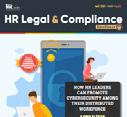
Excellence publications are my ‘go-to’ resource for contemporary and actionable information to improve leadership, engagement, results, and retention. Each edition offers rich and diverse perspectives for improving the employee experience and the workplace in general.




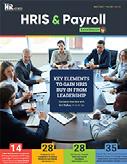
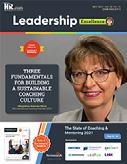
I regularly read and contribute to Leadership Excellence and Talent Management Excellence. I use many of the articles I read to augment my own presentations and I often share the articles with my clients. They are always quick, right on target for the latest issues in my field, and appreciated by my clients. If you want to stay up to date on the latest HR trends, choose a few of the different issues from the Excellence series of publications.

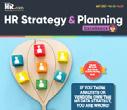

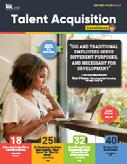

We’re eager to hear your feedback on our magazines. Let us know your thoughts at ePubEditors@hr.com

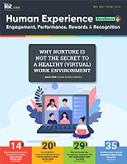
WHY EXCELLENCE PUBLICATIONS?
Julie Winkle Giulioni Author, Virtual /Live Keynote Presenter, Inc.’s Top 100 Leadership Speakers
Dr. Beverly Kaye CEO, BevKaye&Co.
The Future Role Of HR
What should HR focus on?
By The Excellence Publications Team
Thepast few years have been extremely challenging for HR professionals. This year looks no different and is shaping up to be a continuation of many of those challenges – with a few new ones added to the list. From managing investments in people and technology to building a positive workplace culture and employee experience, this year will witness some new trends adding value to the recent transformation that the HR industry has experienced.
Despite the disruptions, the future of human resources management looks promising. And this is the moment HR has to capitalize on in order to drive organizations to success.
According to the Bureau of Labor Statistics, the projected job growth for HR from 2020 to 2030 is 10%. What types of HR roles are going to be in demand moving forward? Where should HR focus their efforts? We have gathered responses from six leaders on this topic.

Submit Your Articles HR Strategy & Planning Excellence presented by HR.com January 2023 7
COVER ARTICLE
HR Must Prioritize Employee Experience

"With companies shifting to permanent remote and hybrid work models, we’re seeing HR teams face new challenges, impacting how they educate, protect and support employees. We expect to see a pivot in HR roles prioritizing AI, cybersecurity, and compliance, especially as the expectation of digital experiences becomes more prevalent. With a tech-enabled workforce, companies will assume more responsibility for managing risk, ensuring that they safeguard employees information without neglecting the shift to automated, real-time solutions. The pervasiveness of economic uncertainty has influenced employees to hold employers accountable to meet key needs.
Moving forward, HR must prioritize employee experience to strengthen mental health, productivity, and workplace posture by building an inclusive culture, providing mental health benefits and resources, and creating an empathetic workplace. Businessolver’s State of Workplace Empathy Report found that workplace empathy drives employee drive: About 70% of employees and HR professionals believe that empathetic organizations drive higher employee motivation.”
Expect a Rise in the Number of HRPs Dedicated to Leadership Development and Organizational Effectiveness

“In the future, we will see an increase in the number of HR professionals devoted to leadership development and organizational effectiveness – think Chief Leadership Effectiveness Officers and Managers/ Directors/VPs of Leadership/Organizational Effectiveness or Organizational Development. As we face an impending economic recession on the heels of the global health pandemic, we know that strong leaders will make the difference between organizations that come out of it tougher and more innovative than before.
In fact, leader and manager effectiveness were deemed a critical priority by Gartner’s 2023 HR Priorities Report and organizations across industries are recognizing the importance of aligning leadership development initiatives to the overall effectiveness and success metrics of the organization. We can expect a rise in the number of HR professionals dedicated to leadership development and organizational effectiveness in the same way we have folks dedicated to talent acquisition and onboarding.”
Submit Your Articles HR Strategy & Planning Excellence presented by HR.com January 2023 8 The Future Role Of HR
Rae Shanahan, Chief Strategy Officer, Businessolver
Maureen Funkhouser, VP of Operations, Entelechy and Former Corporate Learning and Talent Executive
HR Should Keep a Balance Between Technology and Human Experience

“The hot HR job of the future will be one that sits at the intersection of people and technology, and uses analytics and AI to enhance the work of the department. Companies will continue to be challenged with attracting and retaining talent, so the employee experience will take center stage with even more complexity. HR will guide global distributed teams with high expectations for a great work environment and low tolerance for anything less.
HR will need to understand how to capitalize on technology and AI to automate rote tasks and leverage these capabilities to customize experiences for employees. Using analytics to dive deep into trends and really understand the workforce will be key to building organizations where diverse sets of employees can work and thrive. And, yet, HR will also have to lean into the human element of their role, so these jobs will require a high level of acumen for technology, deep leadership and people skills, and agility.”
HR to Focus on Tasks They Have to Accomplish

Our latest research shows that HR professionals will be increasingly focused on tasks they have to accomplish:
● Accelerate business by increasing value for all stakeholders inside and out;
● Advance human capability through prioritized talent + leadership + organization + HR initiatives;
● Mobilize information through data and technology to improve decisions;
● Foster collaboration to build positive working relationships with HR and with all stakeholders;
● Simplify complex to make sure the right things get done.
These “tasks” (note all verbs or actions) will occur regardless of role, whether a generalist in a business or a specialist providing deep expertise.
Submit Your Articles HR Strategy & Planning Excellence presented by HR.com January 2023 9 The Future Role Of HR
Shaara Roman, Founder, and CEO, The Silverene Group
Dave Ulrich, Rensis Likert Professor, Ross School of Business, Partnerthe RBL Group
Hiring Teams Will Need Leaders to Focus on the Intersection of Employer Brand and Candidate Experience
“Talent Acquisition is increasingly more tech-driven. Hiring teams are mostly using technology to become more efficient with fewer resources, regardless of employment market conditions. I think hiring teams will need leaders to focus on the intersection of the employer brand and candidate experience. Titles could include head of candidate marketing because it requires using several technologies, creative services, and digital advertising knowledge to attract, interest, and hire the best quality candidates.
Another job we see emerging is the director of talent experience to create stronger connections between job applicants and brands — a role that blends HR skills, the use of CRM technology, social media, marketing, and brand promotion. And roles like candidate qualification specialist, focusing on qualifying and hiring people with the right skills, or VP of talent pipeline, aligning talent acquisition efforts and resources to directly impact and meet the needs of the business."
People Will Always Be at the Center of What HR Teams Do

“As we navigate a rapidly shifting landscape, one constant is that people will always be at the center of what HR teams do. As technology and automation become more integrated throughout the HR function, we will see a growing demand for team members skilled at analyzing and interpreting data to help deliver HR’s most impactful, strategic efforts.
Learning and development is another critical growth area. A recent Wiley report found that 69% of the HR professionals surveyed said their organization has a skills gap, up from 55% in 2021. Often the best source of talent to close that gap is from within organizations, which requires high-caliber upskilling and reskilling opportunities. Therefore, we will likely see HR teams add roles focused on implementing strategic employee L&D initiatives, expanding workforce training, and delivering flexible education benefits.”

Submit Your Articles HR Strategy & Planning Excellence presented by HR.com January 2023 10 Would you like to comment? The Future Role Of HR
Kermit Randa, CEO, Symphony Talent
Danielle McMahan, Chief People and Business Operations Officer, Wiley
Six HR Trends That Will Shape The American Workplace In 2023
HR professionals should incorporate these trends into their HR strategy
By Emily Hann, Leadpages
As HR teams create their road maps for 2023, they have a lot to consider. From flexible work environments to culture initiatives, employee training, and functional office space, the list can get long. The world of work and employee-employer relationships have fundamentally shifted over the last few years. We will undoubtedly continue to see more changes unfold as we progress through 2023.
After the past two and a half years of uncertainty, most companies have entered calmer waters with hybrid work. They now have clarity about how their employees’ expectations and needs have evolved since pre-pandemic, but gaps remain between what employees need and what employers can provide. As we look ahead to 2023, several key HR trends will likely shape the industry’s landscape.
Increased Cost-Saving Initiatives
With the skyrocketing inflation, employees’ wallets are feeling the pressure. To help retain staff during the labor shortage, HR teams will likely implement creative ways to support their employees in cost-saving measures this year. Beyond handing out increased cost-of-living adjustments, some of these measures could include increasing the employer
contribution towards employee benefit plan premiums, providing commute-to-work reimbursements, employer-paid fitness memberships, or paid parental leave. For folks working from home, employers could offer stipends for Wi-Fi and energy bills or catered lunches and lunch deliveries.
Holistic Employee Well-Being
In the wake of the pandemic and amid a possible recession, employees everywhere are expressing work-related stress and burnout. There is no doubt a 2023 HR trend will be an increased focus on overall employee well-being to ease these stressors. Outside of their physical health, HR teams can provide benefits that address their financial, mental, and emotional well-being.
We will also see many HR teams adopting a more holistic approach to well-being, as simply providing traditional health benefits and paid time off are the bare minimums. This holistic approach could include more mental health support from employers, programs to help employees with financial planning, and social initiatives that bring colleagues together after long periods of isolated work environments.
Submit Your Articles HR Strategy & Planning Excellence presented by HR.com January 2023 11
TOP
PICK
At Leadpages, we’ve recently rolled out a company-paid financial wellness program that offers our employees one-on-one professional financial coaching sessions. Providing financial coaching can help ease stress and improve employees’ quality of life. As a bonus to investing in your team’s well-being decreased financial stress will also lead to positive employee engagement and productivity.
Transparent Compensation Packages
Another trend expected to continue in 2023 is the fine-tuning of public-facing compensation packages. With the increasing competition for top talent, organizations are looking for ways to attract and retain employees through competitive compensation packages. Additionally, as more and more US states roll out legislation surrounding pay transparency, most recently including New York and California, companies are starting to disclose salary ranges on their job postings.
These pay transparency laws could cause headaches for companies and HR teams if they don’t take the time to clean up out-of-date, possibly biased, or discriminatory pay practices with existing team members. As such, there’s no doubt that a significant focus for many HR teams in the US over the next year will be revising their compensation programs, benchmarking strategies, and internal pay equity practices to remain competitive for talent and legislatively compliant.
Mirror Your Flexible Work Perks
The hybrid work environment is here to stay, it’s a permanent fixture in this modern work world. Employees everywhere have made it clear that they are unwilling to give up the work-life balance and monetary savings made possible by flexible work arrangements. HR teams will continue to integrate changes into employee policies and initiatives that support flexible individual preferences, as opposed to the traditional herd approach, when it comes to expectations such as in-office versus remote work, work schedules, perks, and benefits, to name a few.
One aspect of flexible work culture initiatives that HR teams will continue to focus and improve is providing
perks and incentives for both remote and in-office employees, so one is not favored over the other when a true hybrid culture exists.
For example, at Leadpages, we provide an at-home office allowance for those who choose to be remote. We also provide a commute-to-work incentive program for those who prefer to come into the office. This program supports team members who like to come into the office by lessening the associated costs of commuting, regardless of their preferred mode of transportation. For companies looking to build a strong climate-friendly culture, this is a great starting point to reduce and offset carbon footprints while also promoting employee satisfaction.
Building Flexible Workspaces
Speaking of flexible work, 2023 will also introduce a renewed interest in flexible workspaces. An office redesign may be on the horizon for hybrid companies that still maintain physical office space. As we move away from more traditional pre-pandemic layouts of cubicle rows, assigned seating, and a possible lack of aesthetic and overall warmth, we will begin to see more open, comfortable, and flexible-use spaces that are more similar to the comforts of working from home. The thought behind this upcoming HR trend is to take away the vast difference between an at-home office and the traditional office, so it’s not such a shock to the system for those who are truly hybrid, making the in-office days more comfortable and enticing for team members.
Improving Leadership Training
Leaders have felt the growing pain over the last two years as many have been forced to manage hybrid or remote teams for the first time with zero preparation. They had to completely shift their strategies to engage and maintain the productivity of their teams. In addition to a new working environment, they also faced increased retention issues, team mental health concerns, and employees wanting career development support and physiological safety from their employers more than ever before. At this stage, in any industry, it’s not uncommon to see leaders and employees burning out. In 2023, companies should expect to allocate more resources to train leaders on the human side of leadership.
Submit Your Articles HR Strategy & Planning Excellence presented by HR.com January 2023 12
Six HR Trends That Will Shape The American Workplace In 2023
Training topics will likely include soft skills such as emotional intelligence, collaborative communication, and psychological safety, in addition to leadership training in navigating career development and goal-setting discussions with employees.

The Future of The American Workplace
In the coming year, it’s clear that HR professionals will continue to face several challenges and opportunities.
The uncertainty of the past three years has underscored the importance of mental health and wellness, and many organizations are looking for ways to support the overall well-being of their employees. In 2023, this could include offering resources such as mental health support, increased cost–savings initiatives, flexible workspaces, and more.

Attracting and retaining top talent is still top of mind, and there is also an opportunity to develop leaders through additional training.
With planning for the year underway, HR professionals should consider how they can incorporate and implement these trends into their HR strategy. Ultimately, we can add value to our employees—and our business—by embracing these trends in 2023.
Would you like to comment?
Submit Your Articles HR Strategy & Planning Excellence presented by HR.com January 2023 13
Emily Hann is the Director of People and Culture at Leadpages
Six HR Trends That Will Shape The American Workplace In 2023
Claire Essex-Crosby is the Chief People Officer at Eagle Eye. She has over 20 years of experience in HR, having worked in governmental, healthcare, technology, and financial service sectors. She leads every aspect of the employee experience from attracting, developing, and retaining the right talent; to building Eagle Eye’s purple culture; and making Eagle Eye a great place to work. Previously, she held senior HR leadership roles at Hitachi Capital and Nielsen at both national and international levels.
In an exclusive interview with HR.com, Claire Essex-Crosby shares her HR journey and offers valuable insights on various workplace issues, building the HR team of the future, and much more.

CHRO CORNER
Inspiring the Next Generation of HR Leaders
Where do HR leaders draw inspiration from? What are their worst nightmares? How did they stand the test of the changing times?
In this segment, we will trace your journey to the top.
This is your story - a story that is made of extraordinary accomplishments, methods that helped you overcome adversity, innovative programs that you led, and fundamental changes that you brought in. It's your chance to inspire the next generation of leaders.
Exclusive Interview With Claire Essex- Crosby, Chief People Officer, Eagle Eye Solutions Ltd.
Excerpts from the interview:
QWhat has your HR journey been like, and what influenced you the most to positively impact your career?
Claire: My journey in HR has been challenging, complex, and sometimes frustrating; but mainly – exciting and rewarding. One of my primary reasons for getting into HR was to be able to make a difference and help business leaders navigate complex challenges.
I love the role of strategic business partner - being able to work with organizational leaders to solve mission-critical problems is a real privilege. And it’s that ability to build relationships with key stakeholders and make a difference that has most positively impacted my career. That and not being afraid to try new things and re-imagine HR in new ways.
Submit Your Articles HR Strategy & Planning Excellence presented by HR.com January 2023 14
What were your challenges during the early days of your career compared to those of today?
Claire: Three things that come to mind are proving HR’s place at the table and demonstrating it every day; navigating European employment law in a global market; and continuously looking for business process improvements in a new technology-driven world.
What according to you is one of the most overlooked issues facing HR today?
Claire: One of the most overlooked issues facing HR today is the increasing volume and changing nature of the challenges human resources professionals continue to face in the complex and uncertain post-Covid environment. Having to acquire new skills quickly; being able to pivot as new situations emerge; whilst not losing sight of the people who are the heart and soul of our organizations. As businesses put more of a premium on overall employee happiness by creating better employee experiences, much of the work falls on HR. We need to remain agile.
What can HR do about “Quiet Quitting?”
Claire: HR professionals at all levels must continue to engage with their employees. Look for those opportunities to learn and listen, and really listen to what your employees are saying to you. Foster a deep sense of purpose and connection regardless of whether you are office-based, hybrid, or working remotely.
At Eagle Eye, we believe in the power of e-NPS scores. This enables us to get a sense of where our employees are and helps us to identify new ways of hearing their concerns; to ensure we are acting on the things that really matter. You can pay people more or invest in training for example, but if you don’t know what your organization is thinking, how can you be sure your efforts are targeted and are going to make a real difference?
Name:
Designation:
Company:
Total number of employees:
When did you join the current company:
Total experience in HR:
Hobbies:
What book are you reading currently?
Claire Essex- Crosby
Chief People Officer
Eagle Eye Solutions Ltd
240 2017
20 years
Travelling, reading, and history
Do you see any new job roles being created by the transformation?
Claire: I think there will be a continued focus on data insights and artificial intelligence (AI); diversity; and the future of the workplace.
Major HR trends you expect in the next 5 years
Claire: I expect to see more AI in HR processes, especially in hiring and the screening process. I also see HR continuing to reinvent itself and find more creative and agile ways of working. And more quiet hiring – upskilling and reskilling.
What is your leadership mantra?
Claire: Do what is right, not what is easy. And of course, treat others as you wish to be treated.
Submit Your Articles HR Strategy & Planning Excellence presented by HR.com January 2023 15
CHRO Corner Q Q Q
The Neapolitan Novels by Elena Ferrante
Q Q Q
Would you like to comment?
HR Pitfalls To Avoid In 2023
HR can improve the employee experience by prioritizing humancentric approaches to growth
By Naveen Bhateja, Medidata Solutions
Human Resources professionals are facing some obvious challenges heading into 2023. The economic downturn is leading to layoffs and hiring freezes that HR must oversee. At the same time, HR is facing the challenge of leading their organizations through the quiet quitting epidemic
On top of this, there are a number of less obvious issues at play in the workplace that threaten to dramatically affect organizational effectiveness. These pitfalls also require the attention of the People function and special care should be taken to recognize and steer clear of them.
Prioritizing Tech Before People
The HR technology industry is booming. In 2022, it was valued at nearly $24 billion. As a result, HR teams have more digital tools than ever before to assist them with a wide range of tasks. However, if these tools are not designed and deployed with the employee

in mind, they can cause more harm than good.
A recent survey reveals an alarming statistic related to the pitfalls of deploying HR technology in the wrong way: 67 percent of employees are so
frustrated with HR tech that they would be willing to take a pay cut if it meant they could work with more effective platforms. Leveraging tech to streamline HR processes is valuable, but its impact on the employee experience must be carefully considered.
Submit Your Articles HR Strategy & Planning Excellence presented by HR.com January 2023 16
TOP PICK
One way to avoid this pitfall is to champion human-centric HR strategies. It is not enough to understand what a new tech tool can do; leadership must understand how it will add value to their employees as well as the most effective way to deploy it. The true potential of any new tech platform can be realized if employees embrace it.
Generalizing the Employee Experience
Today’s workplace is made up of Boomers, Millennials, and Gen X — some onsite, some remote, and others a hybrid of both — bringing with them a diverse collection of expectations when it comes to the employee experience (EX).
Organizations have come to understand that providing a positive EX is critical for sustaining high levels of employee engagement and performance. However, many in leadership positions have failed to understand that keeping their overall EX positive requires a high level of personalization.
Keeping engagement high requires understanding the unique needs and personalization of the EX in order to meet them. McKinsey & Company suggests that one way to orchestrate a better employee experience is to identify the various “personas” that exist in the workplace and design multiple EX approaches to meet each group’s unique expectations. A critical step in this process is to actively listen to employees and
allow them to inform the EX development process (the same approach an organization would use for customer experience). Communication is key to orchestrating and managing a productive employee experience.
Abrupt Digital Transformation
The Covid-19 pandemic prompted a rapid acceleration in the pace of digital transformation. One survey found that organizations progressed 20 to 25 times faster than expected in transitioning to digital tools. While that pace was essential for addressing the sudden and unexpected changes required by the pandemic, making abrupt digital transformation to the norm will not produce positive results for most organizations.
HR professionals must help organizations to remember that digital transformation involves more than deploying new technology — digital transformation involves a new way of approaching work. Leadership must give employees the time and training necessary to understand why transformation is happening and what it promises to accomplish. Rushing into transformation without the appropriate communication decreases the likelihood of widespread engagement, which ultimately threatens its effectiveness.
Neglecting Data-Driven Analytics
The digitalization of business has produced a wide range of new data streams, many of which relate to the work that People functions perform. However, HR teams have been slow to look at these new sources of data for insights. Failing to value this data and the deep understanding of workplace trends it can provide is a pitfall that HR must avoid.
A recent McKinsey & Company study highlights the potential of using artificial intelligence (AI) to mine HR-related data. The insights derived from AI-driven analytics can provide better results on a wide variety of HR responsibilities, including recruiting, performance assessments, and employee engagement. Reskilling HR teams or bringing in new talent that is adept at data analytics is one way to ensure that organizations do not neglect the value data-driven analytics can provide.
Another potential pitfall to avoid in leveraging AI-driven analytics is that HR practitioners must be aware of any inherent biases and be sure to avoid them. Bias can creep into algorithms in several ways. AI systems learn to make decisions based on training data, which can include biased human decisions or reflect historical or social inequities, even if sensitive variables such as gender, race, or sexual orientation are removed.
Submit Your Articles HR Strategy & Planning Excellence presented by HR.com January 2023 17
HR Pitfalls To Avoid In 2023
Taking An “Employee First, Person Second” Approach to Management
One of the lessons learned from the Great Resignation is the need for human-centric HR models. Employees are people who bring their lives with them to work. Organizations that fail to see their workers as people first and employees second will ultimately lose their attention, their engagement, and their productivity.
Providing flexibility is one of the key practices HR needs to consider in this area. Remote and hybrid work models acknowledge that balancing work and home life is important. Organizations that ignore that reality will find themselves challenged to attract and retain talented and committed employees.
Another key practice necessary to avoiding this pitfall is prioritizing employee wellness. Gallup’s State of the Global Workplace 2022 Report found that employee burnout costs businesses $322 billion in turnover and lost productivity costs. HR should initiate programs that promote employee well-being and proactively seek ways to improve it. Taking steps to acknowledge a worker’s struggles with empathy and provide guidance on how they can be overcome communicates that they are seen as a person first and an employee second.
Limiting Internal Growth Opportunities
Retaining talent is one of the top challenges businesses will face
in 2023, with reports showing that one in three employees is planning to look for a new job in 2023. One of the best ways to avoid losing talent is to provide employees with growth opportunities.
A recent survey revealed that nearly 70 percent of employees would stay at their jobs if their employers offered upskilling opportunities. The same survey revealed that 49 percent of employers struggle with offering those opportunities to their employees. HR teams that work to integrate these opportunities into the employee experience can provide their organizations with a competitive edge when it comes to attracting and retaining top talent.
Rejecting a Growth Mindset
If the past 3 years have taught us anything, that is the fact that change is inevitable and the world around us is shifting quickly.
Managing change and avoiding the pitfalls listed above require a willingness to develop new skills, accept new ideas, and embrace new paradigms. To accomplish that, HR professionals must value and develop a growth mindset. The HR space is ever-changing, meaning those who work within it must also be willing to evolve.
One essential characteristic of the growth mindset is the willingness to try, fail, and learn
from failures. For HR, this means, taking the time to honestly assess the success of platforms and systems and accept the findings of those assessments. If new HR tech is not being utilized as expected, training may need to be revamped. If digital transformation is not being embraced, the pace may need to be adjusted. If burnout is common among workers, employee wellness may need to be better promoted.
In general, a growth mindset is key to overcoming challenges and adapting to new realities. By modeling a growth mindset, HR can set the pace for the rest of the organizations, better positioning them to succeed in 2023 and beyond.
Naveen Bhateja operates as the head of the People Organization as EVP, Chief People Officer at Medidata Solutions, where he leads an ecosystem comprised of Strategic People Partners, People Operations, Talent Acquisition, Diversity, Equity, and Inclusion, Workplace Benefits and Resources, and Corporate Social Responsibility. As a member of the senior leadership team, Naveen operates as a business strategist and trusted advisor and believes that people strategies empower successful business outcomes.
Would you like to comment?

Submit Your Articles HR Strategy & Planning Excellence presented by HR.com January 2023 18
HR Pitfalls To Avoid In 2023
A Lack Of Remote Work Options May Be Causing Employee Turnover
How HR teams can meet the demand for remote work
By Josh Millet, Criteria
After a crisis as destructive and destabilizing as the Covid-19 pandemic, the desire to “get back to normal” is natural. But while the world is returning to normal in many ways – people are traveling again, mask mandates have been dropped, and so on – we’ve also witnessed a series of fundamental and permanent changes. Nowhere is this shift more apparent than in how and where we work, a transformation that HR teams are especially focused on.
Many companies are eager to get back to “normal” as quickly as possible, and this often means ordering employees back into the office. But according to our 2022 Hiring Benchmark Report – in which we surveyed over 500 hiring professionals at companies of all sizes and across industries –this policy could be putting those companies at a serious competitive disadvantage. Companies that are mostly in-person are seeing higher rates of turnover than their
remote and hybrid peers, and this is a particularly serious impediment in the middle of a tight talent market when employee retention is already a major issue.
HR teams have to recognize that employee expectations about workplace flexibility and autonomy will never be the same. They should develop policies that take these changes into account, from remote work options to a culture built around meeting employees’ individual needs. The companies that adapt to new employee demands will be in a stronger position to attract and retain talent than those that continue to resist change.
Companies that Require In-Person Work are Losing Employees
For many companies, the shift to remote work was a reluctant
necessity and returning to the office was always the end goal. However, our survey found that this plan may not be working out: 56 percent of the companies that are mostly in-person say employee turnover is a major issue, a proportion that drops to 50 percent for companies that are hybrid (a mix of remote and physical work) and 41 percent for companies that are mostly remote.
A significant majority of companies can see that the pre-pandemic status quo is likely gone forever. While 39 percent of our survey respondents say their workplaces are mostly in-person, 61 percent are either mostly remote or hybrid. These policies are meeting a clear employee demand: a May 2022 PwC survey found that 63 percent of employees whose jobs can be done remotely say they “prefer some mix of in-person and remote working.”
Submit Your Articles HR Strategy & Planning Excellence presented by HR.com January 2023 19
It’s no surprise that the companies that fail to meet these demands and expectations are losing employees. Half of the companies we surveyed answered “yes” when we asked if employee turnover is a major issue, while just 38 percent said “no.” It has never been more critical for companies to prioritize employee retention and implementing the right remote work policies is an integral part of this effort.
How Remote Work Policies Are Tied to Retention
Despite the fact that employees are increasingly demanding remote work options, many companies are requiring employees to show up in person. These companies appear to believe that the shift to

remote work was a historical aberration rather than the catalyst for a long-term change in how employees work. The evidence suggests that this belief is mistaken, and this is mainly because employees’ attitudes toward remote work are expressions of more fundamental preferences and concerns.
Our survey found that there’s a mismatch between companies’ perceptions of what prospective employees want and what they actually want. Although hiring professionals rank compensation as job candidates’ top priority, candidates are more interested in securing the right work-life
balance. It isn’t difficult to see how the availability of remote work opportunities is connected to work-life balance for many employees. When employees are able to decide where they work, they will have more flexibility to travel, see family and friends, and determine exactly what their work environments look like.
According to our survey, 56 percent of companies have implemented an RTO plan this year – a proportion that surges much higher in certain industries, such as transportation and logistics, the public sector, and manufacturing. As the pandemic recedes and companies reassess their policies, they shouldn’t forget that the desire for remote work isn’t going anywhere.
Submit Your Articles HR Strategy & Planning Excellence presented by HR.com January 2023 20
A Lack Of Remote Work Options May Be Causing Employee Turnover
How HR Teams Can Meet the Demand for Remote Work
One of the most important elements of employee retention in the coming years will be HR teams’ ability to fully leverage remote work. This process won’t be the same for all companies, but there are several essential issues HR professionals should keep in mind. First, they should have a candid, ongoing conversation with employees about their needs and concerns. Second, they should ensure that their workplace culture is conducive to remote work. And third, they should focus on the underlying priorities which drive the demand for remote work.
Despite the prevalence of remote work, a Gartner survey found that less than half of employees believe remote work is “destigmatized”
at their companies, while 70 percent believe “on-site workers are more likely to be promoted and paid more compared to remote workers.” These are reminders that the mere implementation of remote work policies isn’t enough – HR teams also have to integrate remote workers with their in-person colleagues, provide the resources remote workers need, and establish guidelines and standards that are fair to all employees.

At a time when companies are struggling to attract and retain talent, remote work is a key differentiator that will set them apart from their competitors. While a desire for normalcy is understandable – especially for HR professionals who have been through an extremely
difficult few years – it’s long past time to acknowledge that remote work is here to stay.
Josh Millet is the Founder + CEO of Criteria, a venture-backed ($64.3M) talent success company that helps organizations make more objective, evidence-based talent decisions that both reduce bias and drive outcomes. Prior to launching Criteria, Josh co-founded an online test preparation company, Number2.com, which was acquired by Xap Corp in 2002.
Would you like to comment?
Submit Your Articles HR Strategy & Planning Excellence presented by HR.com January 2023 21
A Lack Of Remote Work Options May Be Causing Employee Turnover
HRCI® & SHRM® CERTIFICATION PREP COURSES
GROUP RATES AVAILABLE
For HR Professionals
Show that management values the importance of the HR function, and has a commitment to development and improvement of HR staff.
Ensure that each person in your HR department has a standard and consistent understanding of policies, procedures, and regulations.
Place your HR team in a certification program as a rewarding team building achievement.
For Your Organization
Certified HR professionals help companies avoid risk by understanding compliance, laws, and regulations to properly manage your workforce.
HR Professionals lead employee engagement and development programs saving the company money through lower turnover and greater productivity and engagement.
A skilled HR professional can track important KPIs for the organization to make a major impact on strategic decisions and objectives, including: succession planning, staffing, and forecasting.
|
HR.com/prepcourse CALL TODAY TO FIND OUT MORE 1.877.472.6648 ext. 3
sales@hr.com
1 . Less expensive than a masters or PhD program, and very manageable to prepare with
2. legislation and best practices
3. Recognized, Industry benchmark, held by 500,000+ HR Professionals
Group Rate Options
We offer group rates for teams of 5+ or more for our regularly scheduled PHR/SPHR/ SHRM or aPHR courses.
For groups of 12+, we can design a more customized experience that meets your overall length of the course.
Groups rates for HRCI exams are also available as an add-on.
All group purchases come with 1 year of HR Prime membership for each attendee to gain the tools and updates needed to stay informed and compliant
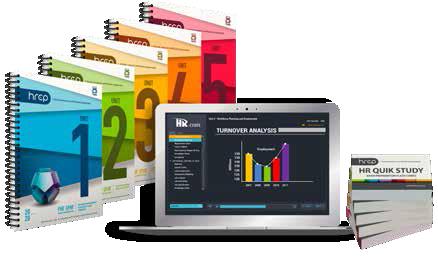
CALL TODAY TO FIND OUT MORE
1.877.472.6648 ext. 3 | sales@hr.com | HR.com/prepcourse
1 2 3
How Human Capability Initiatives Deliver Value To All Stakeholders
Governance and guidance for growth through human capability
By Dave Ulrich, Ross School of Business and Norm Smallwood, The RBL Group
Likemany others, we have spent our career seeking to discover how to create value for all organization stakeholders inside (employee fulfillment and strategic realization) and outside (customer share, investor confidence, and community reputation) through people and organization practices. This elusive, but relevant, aspiration has inspired ideas, research, and experiments. We are closer to this holy grail (or pot of gold at the end of the rainbow) today because of progress on three efforts: outcomes, frameworks, and research.
Outcomes That Matter
Because of technology, political, demographic, and social contextual changes, about 80 percent of firms’ market value today comes from intangibles (up from 20 percent in the last twenty years)—intangibles representing the ability to adapt to these changes. Further, access to funding, strategic declarations, and digital innovations are less differentiating than the ability to manage people and organizations.
As a result of these contextual changes and competitive demands, HR (broadly defined) is less about HR and more about the outcomes of doing HR work. For example, good people and organization work is less about the number of days of training, CEO-to-employee pay ratio, time to hire, workforce

policies, or other initiatives and more about the impact on customers, investors, and communities. Simply stated, if an organization does not succeed in the marketplace, it has no workplace.
This focus on outcomes more than activities makes people and organization investments more relevant, and even material, to investors, boards, and senior executives. The recent U.S. Securities and Exchange Commission (SEC) requirement to disclose human capital in regulatory reports signifies the increasing interest in people and organizations. With little direction about what should be disclosed, about 7,000 U.S. firms reported a host of initiatives and metrics in 2021.
Submit Your Articles HR Strategy & Planning Excellence presented by HR.com January 2023 24
TOP
PICK
Framework for Progress
Because of increased attention to people and organization issues, a profusion of ideas and actions—many of which do not focus on outcomes— have shallow or non-existent roots in previous work, lack research evidence to support them, and end up as shiny objects and fads. To counter this quick-fix mentality, we have been actively engaged in the last few years in three relevant and large research projects:
1. HR Competency & Capability Study, concluding the eighth round of data in 2021 with 28,500 respondents (over 120,000 people surveyed over the life of the study).
2. Organization Guidance System with over 1,000 companies.
3. Governance and Guidance for Growth through Human Capability (G3HC, with 7,000 companies).
From this research and our experiences, we propose a simple but integrated framework for the HR field: Human Capability (talent + leadership + organization + HR department).
● Human refers to talent (human capital, employee, workforce, people, competence).
● Capability refers to the organization (team, workforce, capability).
● Leadership bridges the two.
● HR function refers to the HR department, practices, and people that deliver value.
This Human Capability framework clarifies and evolves the HR profession (see figure 1 for the evolution of field).
Investors, boards, and business leaders can explore each of the four Human Capability pathways and link them to stakeholder outcomes. HR professionals, as architects, can diagnose performance in each pathway and offer blueprints for progress.
Innumerable innovations proliferate in each of these four pathways (see figure 2 for thirty-seven initiatives across the four pathways). Having a way to integrate these innovative initiatives allows organizations to progress in ways that build on each other rather than having isolated and often repackaged initiatives. These four pathways are like the four food groups that lead to many diets, the GAAP principles that shape financial decisions, or the big five personality traits that offer numerous personality assessments, etc.
We are encouraged by this “framing” of HR that may become a foundation for the field. In any business discussion related to people and organization, these four pathways may be the basis for dialogue and investments.

Submit Your Articles HR Strategy & Planning Excellence presented by HR.com January 2023 25
How Human Capability Initiatives Deliver Value To All Stakeholders
Evolution of HR Field to Human Capability
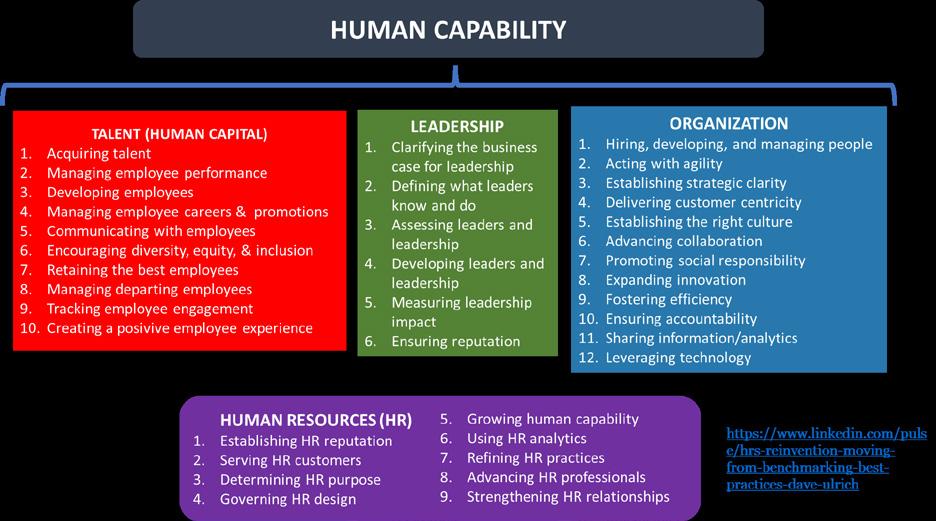
Thirty-Seven Initiatives in Four Human Capability Pathways
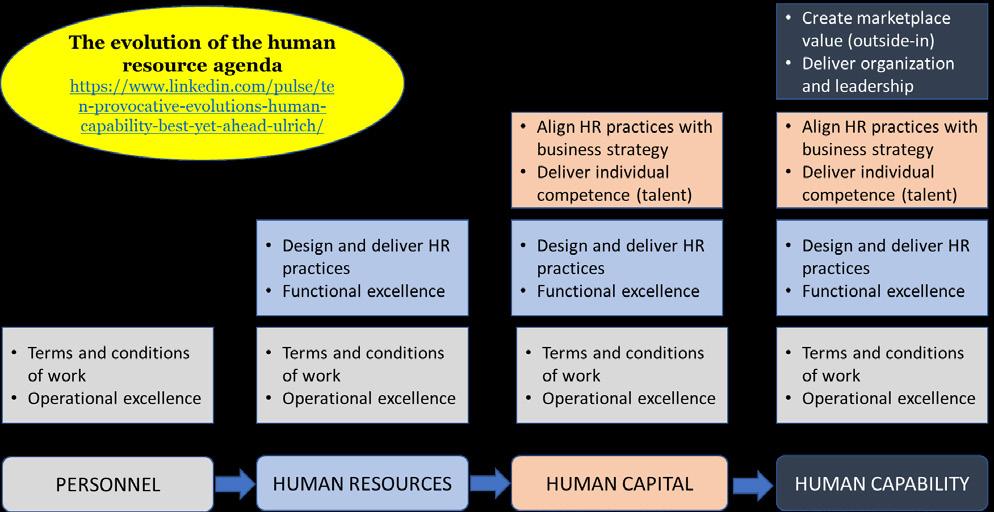
Submit Your Articles HR Strategy & Planning Excellence presented by HR.com January 2023 26 How Human Capability Initiatives Deliver Value To All Stakeholders
Figure 1:
Figure 2:
Research with Actionable Insights
Most efforts to assess the four pathways and thirty-seven initiatives come from surveys that ask respondents to offer their views on scripted questions. Surveys collect information but have response bias, limited information sourcing, and multi-collinearity findings. For research to lead to actionable insights, we access information with the advance of machine learning, AI, and natural language processing, which takes us beyond traditional surveys.
In partnership with Amazon Web Services AI experts, we were able to use machine learning and Natural Language Processing (NLP) to score 7,000 organizations on the extent to which they disclosed efforts in each of the four pathways. For 5,700 of these firms, we were able to run predictive analytics about how Human Capability overall as well as in each
of the four pathways impacted employee, financial, and social reputation outcomes.

Our findings are remarkable (see figure 3.) Human Capability scores explain
● 44 percent of employee productivity.
● 26 percent of cash flow (EBITDA) (also 25 percent of market value over intrinsic value or intangibles [Tobin’s Q]).
● 36 percent and 48 percent of two social responsibility indicators.
These results are nearly double the industry average for the impact of Human Capability on these results as measured by surveys (figure 3). This validates the reliability of our Human Capability framework and the machine learning / AI methodology for explaining results.
3: Results of Human Capability on Key Outcomes
Employee Productivity: Revenue\employee
Figure
Finance: Cash flow (EBITDA)
Finance: Tobin’s Q (value to book)
Social Responsibility: Fraud
Social Responsibility: Litigiousness
Submit Your Articles HR Strategy & Planning Excellence presented by HR.com January 2023 27
Human Capability R2 .445 R2 .261 R2 .253 R2 .359 R2 .484 How Human Capability Initiatives Deliver Value To All Stakeholders
Investors, boards, senior business leaders, and HR professionals who seek higher confidence in employee, financial, and citizenship results should oversee and make informed Human Capability investments.

Clearly, SEC human capital reports are not perfect sources of data on Human Capability. Companies differ on what they disclose because what they are doing and how transparent they chose to differ. However, over time, the SEC reporting on Human Capability will likely evolve, and disclosures may eventually more closely match the rigor of financial, strategic, and risk management information.
Implications for HR Profession, Your Company, and You
We have called our work in this domain Governance and Guidance for Growth through Human Capability
(G3HC). It provides a conceptual and empirical foundation to upgrade and evolve the HR profession by making progress on how Human Capability initiatives deliver value to all stakeholders and by informing SEC disclosures.
The work also helps any organization profile their current (see figure 4) and determine desired Human Capability investments to make intentional choices for improvement as well as what to disclose, drawing on thirty-seven actionable insights from our work.
Most importantly, this work helps business leaders and HR professionals make conscious Human Capability choices that help them be effective.
Submit Your Articles HR Strategy & Planning Excellence presented by HR.com January 2023 28
How Human Capability Initiatives Deliver Value To All Stakeholders
For further insights, Check www.g3humancapability.com
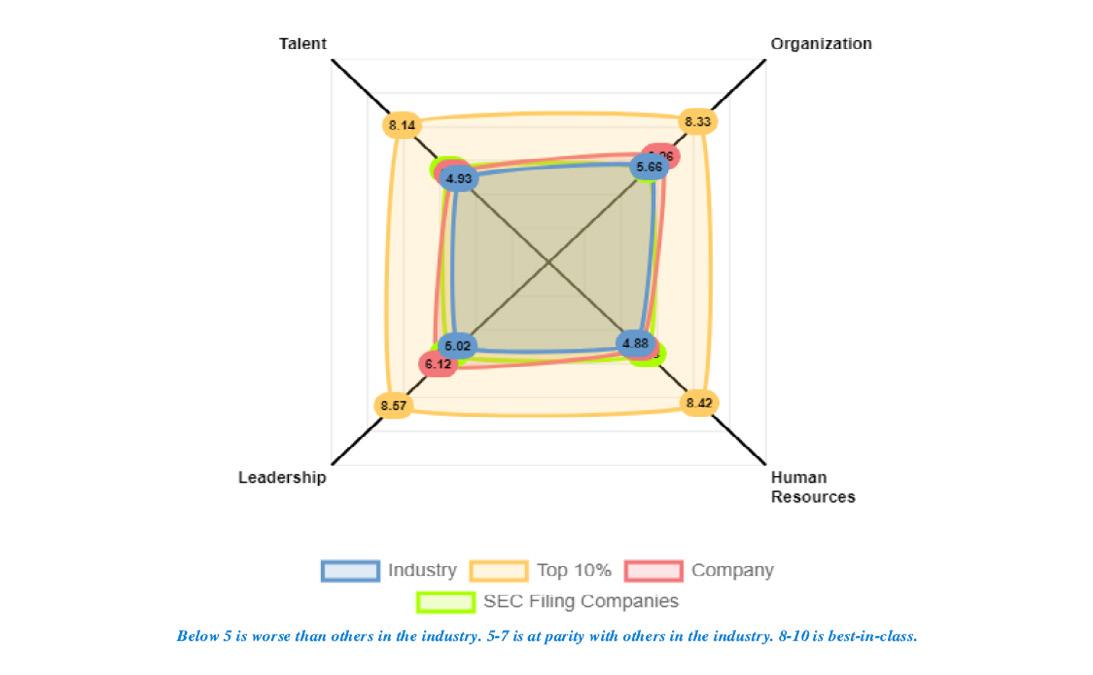
Dave Ulrich is the Rensis Likert Professor of Business at the Ross School, University of Michigan, and the Co-Founder & Principal at the RBL Group. He has helped generate award-winning databases that assess alignment between external business conditions, strategies, organization capabilities, HR practices, HR competencies, and customer and investor results.

Norm Smallwood is a Partner and Co-Founder of The RBL Group. He is the co-author of eight books: Real-Time Strategy, Results-Based Leadership, How Leaders Build Value, Change Champions Field Guide, Leadership Brand, Leadership Code, Leadership Sustainability, and Agile Talent. Norm was a founding partner of The Novations Group, Inc. where he led business strategy, organization capability, and design projects for a wide variety of clients spanning multiple industries and geographies.
Would you like to comment?

Submit Your Articles HR Strategy & Planning Excellence presented by HR.com January 2023 29
How Human Capability Initiatives Deliver Value To All Stakeholders
Technology And Workplace Predictions 2023
4 trends which might just defy conventional wisdom
By Jeetu Patel, Cisco
Predicting the unexpected is a tricky business. Especially in technology and business, where constant change and disruption are a given. But that won’t stop me. So, here are four trends that I expect to play out in 2023—all of which might just defy conventional wisdom.
Beyond the Age of Malware: From Detection to Prediction
In 2023, we will move beyond the age of simple malware because just detecting malicious code won’t be enough to combat the sophistication
of current threat actors (who use modern ‘toolkits’ consisting of modular malware). The next evolution of security is about sensing anomalies and behavior patterns, which will aid in predicting a breach. Advances in AI and machine learning will make this possible, and smart organizations will get ahead of this trend.
The Next Critical Influencer for Technology Purchases? Human Resources
Hybrid work has changed so many dynamics within an organization, including buying patterns. Human resources (HR) has traditionally focused on work-related software like Workday, but with hybrid work so essential to productivity and worker satisfaction, HR will continue to get more involved in technology software influencing. In 2023, look for HR to expand its knowledge of and influence in all kinds of technology and software purchases.

Submit Your Articles HR Strategy & Planning Excellence presented by HR.com January 2023 30
Choice Over Mandates Will Matter More Than We Think
Another disruption to hybrid work will be the countless employees who will not want to go back to rigid, in-office work schedules. Many organizations may choose to double down on workplace mandates in 2023, but they’ll ultimately lose. Progressive companies will create a flexible, secure hybrid-work experience and a great physical workspace — that people will want to visit, but only when they choose to or the work calls for it. Such organizations will win on talent, agility, sustainability, and worker satisfaction and see long-term success.
An Uptick of Technological and Ethical Dilemmas with Transformative AI
AI and machine learning have pretty much stuck to relatively rote (but
helpful!) tasks. We’ve already seen mind-blowing capabilities from DALL-E, for example, and in 2023, there’s no doubt even more truly transformative AI use cases will emerge. The next era of AI, and the use cases that follow, will have big implications in 2023 and beyond — both good and bad. As AI continues to take over important decision-making (such as employee recruitment or deciding who gets approved for loans), bias may become an unfortunate “side effect” of utilizing such technology.
Additionally, AI will also enable more advanced scams, incidents of identity theft, convincing deep fakes, and more. Despite the tremendous positive impact AI can have, it’s more critical than ever that the industry ensures responsible and ethical use cases,

guidelines are implemented, and, when appropriate, restrictions win out.
Jeetu Patel is Cisco’s Executive Vice President and General Manager of Security and Collaboration. Jeetu combines a bold vision, steeped in product design and development expertise, operational rigor, and innate market understanding to create high-growth Software as a Service (SaaS) businesses. Prior to joining Cisco, Jeetu was the Chief Product Officer (CPO) and Chief Strategy Officer (CSO) at Box, a role he pioneered.
Would you like to comment?

Submit Your Articles HR Strategy & Planning Excellence presented by HR.com January 2023 31
Technology And Workplace Predictions 2023
HR Teams Can Use AI To Decipher And Respond To The Labor Market’s Mixed Signals
By Rebecca Jones, Mosaicx
for workers is intense. As states reopened their economies in 2021, employers drew from a smaller pool of available workers. Wages increased, and job openings soared, remaining high in 2022. The number of workers quitting their jobs has also remained elevated.
Demand
Despite the number of job openings, the unemployment rate ticked up to 3.7% (by 306,000 people) in October. The new data comes amidst ongoing layoffs, as seen in the tech industry
This “contradictory labor market” leaves business leaders, including HR teams, scratching their heads, potentially unsure how to move forward.
Examining How the Complex Labor Market Impacts HR
The unprecedented number of U.S. workers leaving jobs across industries in the Great Resignation — and
the resulting mad dash of hiring — added to the pressure on HR teams struggling to keep a pulse on their current employees.
Workforce planning is an essential function of HR. HR professionals must understand talent supply and demand and how it relates to the company’s goals. Achieving this perspective has been tricky in today’s market. At the same time, HR teams (like other departments) are strapped for talent. They’re responsible for balancing workforce planning with fewer resources.
How AI Can Support HR Operations
AI solutions can streamline HR processes, enable automation, and increase productivity and savings. Diverse sectors are finding that AI is an effective solution for HR and business operations. In fact, 25% of companies already use AI to support recruiting, hiring, training, performance management and other HR-related operations.
Submit Your Articles HR Strategy & Planning Excellence presented by HR.com January 2023 32
Businesses can preserve, empower and maximize existing resources and talent by introducing automation.
TOP PICK
Below are three examples of how AI can support HR operations.
Innovate Recruitment and Reduce Hiring Bias
Job seekers have been in the driver’s seat since the Great Resignation. Employers can adjust their recruiting processes in new and innovative ways to find talent to fill open positions. AI is one tool HR teams can use to innovate the recruitment process. For example, AI and machine learning can filter applications and flag profiles that match the job description. AI can also determine what candidate sources provide the best-matched workers, which can improve a company’s recruiting efforts.
AI can also play a vital role in helping businesses avoid bias in job advertisements and descriptions. Biased language in job descriptions can discourage capable and talented candidates from applying for a position for which they are ideal. AI-enabled

tools can analyze job descriptions to highlight and remove discriminatory language. These tools might identify biased language such as “guru” or “ninja.”
They might also encourage gender-neutral pronouns. Ultimately, AI-enabled tools can suggest changes without sacrificing the passion and impact you want to demonstrate to potential applicants.
Streamline Operational Tasks Such as Scheduling
Today’s employees want flexible schedules, and they want to manage their schedules autonomously. Businesses can deliver on these expectations with intelligent virtual agents (IVAs). An IVA is an AI-powered software that engages humans in natural and sophisticated conversation. Let’s say an employee needs to adjust their scheduled shifts. The employee can easily text or call an IVA to notify leaders of the change and suggest alternative staffing options. Leaders and HR teams can then use the IVA to share the updated schedule with other employees.
Submit Your Articles HR Strategy & Planning Excellence presented by HR.com January 2023 33
HR Teams Can Use AI To Decipher And Respond To The Labor Market’s Mixed Signals
Not only do IVAs streamline shift changes, but they grant the autonomy workers want.
Answer Questions About Company Layoffs
As previously mentioned, some industries are experiencing large-scale layoffs. The way a company communicates a reduction in staff can have an impact on its current workforce, future employees, and reputation. AI-enabled tools can support a company’s communications efforts about layoffs.
For example, an HR team can create an FAQ for employees to reference. The FAQ can answer questions about the state of the business, what led to the reduction in force, what actions they’re taking to support affected employees, what remaining employees can expect going forward, etc. Companies can then program their IVA to answer these questions from employees and direct them to knowledge base articles for more information.
The labor market has been sending mixed signals for a few years now. HR teams can decipher and respond to these mixed signals with the help of AI and AI-enabled tools. Businesses can preserve, empower and maximize existing resources and talent by introducing automation of everyday tasks and improving communications.

Rebecca Jones is the general manager of Mosaicx. In her career of 25+ years, she has held a broad range of operations executive roles focused on growing businesses, people, and profit margins. Rebecca also serves as a member of the board for the Families for Effective Autism Treatment (FEAT) of Louisville.
Would you like to comment?

Submit Your Articles HR Strategy & Planning Excellence presented by HR.com January 2023 34
HR Teams Can Use AI To Decipher And Respond To The Labor Market’s Mixed Signals
Best-in-Class Education For All Your Learning And Training Needs
HR.com prepares HR leaders to be strategic business leaders by curating and delivering best-in-class products and services so you don’t have to waste time seeking out content on your own. We leverage technology and experience to provide you with customized solutions to best meet your professional development needs at every stage of your career.
From on-demand to cohort-based offerings, below is a listing of virtual courses that will challenge and empower you by giving you the tools to drive innovation and success in your organization.
Shift Corporate Coach Program™
Learn practical coaching skills and tools you can put to work in your organization right away with the first part of the Shift Corporate Coach Program™ on HR.com! This 2-part program provides business leaders with the right coaching toolset for ultimate coaching success through an independent online learning program and live virtual coaching clinics and circles.
HR 4 Non-HR Managers
A new virtual course to help your managers maximize their potential! Inspired by HR.com’s educational book, HR Fundamentals for Non HR Managers, this virtual course will equip managers and supervisors with strategies, knowledge, how-to’s, and hands on exercises to effectively lead people with an HR lens.
ABCs of HXM
Introduction to Human Experience Management (HXM). This virtual course will give you an introduction to HXM through an interactive learning experience. Learn about HXM, its components, and how to apply it to optimize the employee journey, and to create inspired more fulfilling work environments and interactions with all stakeholders that lead to better business results.
HR Analytics for Business Partners
Become a more data driven HR Professional. This course will arm you with the skills to create data-driven interventions that solve real problems and provide you with the skills you need to present your findings back to the business and make a convincing case.
Quality Management Basics
This course provides a firm foundation for anyone looking to understand quality management practices and techniques.
Data Analysis for Improving Organizational Performance
When using data analysis to improve organizational performance, it’s vital to employ the tools that bring the data to life and keep people engaged in the process. Organizations in both the public and private sectors often use tools and frameworks to deliver the data, and the information the data might suggest, to its staff. This intermediate-level course will explain some of these measures and tools, describe some specific measurements, and explain the relationship between assessment and strategy.
Gain access to more expert-led courses.
At HR.com, we are committed to educating and inspiring HR professionals and helping them build meaningful and impactful careers. With products and resources rooted in education, research, and leveraging cutting-edge technology, we help at every career stage - and over 1.92 million HR pros agree! (How could that many people be wrong?) By delivering best-in-class learning products, 250+ annual webcasts and 30+ world-class events, and innovative and thought-provoking research through the HR Research Institute, HR.com strives to inspire and strengthen workforces to change the world. HR.com also offers the most comprehensive HR certification exam preparation and guarantees a passing score on all SHRM and HRCI certification exams. Technology and experience drive our customized solutions that will help you become the best and most successful version of yourself.
HR Strategy & Planning Excellence presented by HR.com January 2023 35
Flexibility At Work: The Need Of The Hour
Measure productivity by results, not days of the week or hours at a computer
By Scott Day, Alludo
You’ve probably been hearing a lot about four-day work weeks recently. And it may sound very appealing.
Believe me, I get it. The pandemic blurred the lines between work and life like never before. And as businesses try to figure out what work looks like now, knowledge workers are struggling with long hours, not to mention bosses that are trying to force them back into the office. People are reporting more stress. They are wishing they could regain their time, prioritize their lives, work where they feel most productive, and frankly, set better boundaries.
So, when we hear about the mandated four-day work-week, many of us think: “Hum... maybe that’s it.”
But here’s the plot twist: As a people leader, I have given this a lot of thought. I am not convinced we will fix this problem by forcing knowledge workers to work four days instead of five.
And it is not for the reason you think.
It’s not because I think productivity will drop.
It’s not because I think employees will disengage.
It’s not because I can’t make it make financial sense.
It’s not because I am a tyrant who loves to see people glued to their office chairs.
It’s because it’s
not enough freedom
The four-day workweek is still an employer-prescribed, top-down methodology that is too focused on input (hours spent in the chair) versus output. It still fails to see people as unique individuals and treats us all as if we have the same needs, preferences, and demands. While I certainly agree that a four-day workweek might be perfect for some people, I’m an even bigger believer in freedom. I honestly don’t think the times, days, and hours you work – never mind where you work – should be dictated by the company you work for at all.
So, What IS the Solution?
True flexibility at work. And that means working wherever, however, and whenever you want. The best employers focus on outcomes, not inputs. They want to know if you are getting your job done and doing it well. They couldn’t care less whether you prefer to wake up at the crack of dawn and hit the ground running, or spend the day with your family and focus on work at night.
Submit Your Articles HR Strategy & Planning Excellence presented by HR.com January 2023 36
Flexibility and freedom at work do not mean leaving work early to watch your kid’s soccer game. It means that watching a soccer game in the middle of the day isn’t “leaving early” at all.
Sure, there are times when the team will need to align schedules for a meeting or a deadline. But that noon meeting might be the beginning of the day for some and the end for others. It might be a quick moment of work to focus on an otherwise non-work day. And if you have a global workforce, flawless alignment on work timing is not realistic anyway.
This is not just about making a more welcoming workplace for employees, though that is a big part of it. It is also a smart business.
I have found that freedom and flexibility are not only great for people, but also for our company. During the pandemic, knowledge workers everywhere proved that productivity did not require an office. And it goes without saying that work/life balance can be dramatically improved by removing the artificial constraints of “industrial-era” 9-5 office work. When the focus is on results instead of counting people sitting in cubicles, employees discovered they could make more space not only for their lives and families but also for their careers.
Why Wouldn’t We Want to Lean into That?
Yes, a four-day workweek might work great for some. Maybe you think it is perfect for you and your
life. And if you do, you should have the right to ask your employer for it. But if you are considering implementing it at your company (or already have), please think twice before making it mandatory and dictating the specific day people need to take off.
Don’t hop on the trend because it sounds enticing when it is just the same old archaic work structure in different clothing. Challenge yourself to explore what true freedom and flexibility at work would look like.
Different roles and businesses come with a variety of requirements, and of course, I cannot speak universally. For many workers, set hours and locations are absolutely necessary. (Thank you, first responders and frontline workers who turn up every day when and where we need you!) But for knowledge work – where outputs mean so much more than time or location – I encourage leaders to embrace a philosophy that puts the individual first.
True flexibility and freedom mean treating employees like whole people who should be able to make their own choices. We should be measuring productivity by results, not days of the week or hours at a computer.
Scott Day is the Chief People Officer of Alludo. He lives by a people-first philosophy that emphasizes freedom and connection to build supportive and high-performing teams. Scott has a passion for driving organizational change, shaping culture, and delivering business results in fast-paced, collaborative environments. He’s played a pivotal role in spearheading Alludo’s remote-first transformation and creating an environment that embraces employee well-being with ERGs (Employee Resource Groups), great benefits, wellness days off, and more.

Submit Your Articles HR Strategy & Planning Excellence presented by HR.com January 2023 37
Flexibility At Work: The Need Of The Hour
Would you like to comment?

ePublication EditorialCalendar2023 Checkoutthenewandupcoming themedHRtopicsinHRStrategy& PlanningExcellence. Check ePublications Editorial Calendar Here. Would you like to submit an article? | Write to us at ePubEditors@hr.com Submission Guidelines 1 HR For Small Businesses Feb 2023 2 The Next Wave of Automation at Work/ Ethical AI and Blockchain Mar 2023 3 Metaverse and the Future of Work Apr 2023 4 The Future of HR's Role in Organizational Success May 2023 5 HR Tech: What’s New and What’s Ahead Jun 2023
Getting Cost Optimization Right
Tips to avoid common mistakes when implementing cost optimization strategies
By Nick Shah, Peterson Technology Partners
Therewas a lot of debate on whether or not the U.S. will enter into a recession by year’s end. Two consecutive quarters with negative GDP growth later, it’s seeming inevitable. The last quarter also saw a rise in inflation, a decline in the stock market, and an inverted treasury yield curve. While the job market continues to stay strong the Federal Reserve has indicated that interest rates will continue to rise through the year, in an attempt to combat inflation. These are all traditional indicators of a slowing economy and we could enter into a recession by the end of the current financial year i.e. 2022-2023.
Coupled with the economic slowdown is the recent pandemic, the effects of which we are still feeling and will continue to do so for some time to come. The global economy is yet to recover fully from the COVID crisis, though the US has fared better than most.
Pressure Leads to Errors in DecisionMaking
In the face of looming uncertainty over recovery from this pandemic, executives and leaders are under a lot of pressure to restructure their organizations to reduce costs while maintaining performance and staying competitive. According to a recent study by Gartner,
“Nine in 10 organizations resorted to cost reductions in response to the pandemic-driven recession. This is expected to continue, with more than three times as
many executive leaders expecting cost reductions to continue, rather than abate, in the coming 12 months.” (Finance Research Team, Gartner, 2022)
While restructuring is the right move, the unusual circumstances we’re all operating under could lead to errors cropping up in executive decision-making. Spotting them in advance will help businesses make better choices in the coming months.
Unintentional Mistakes
Whether you’re making time-sensitive decisions about cutting overheads, reallocating resources, or funding growth, leaders need to recognize common cost optimization errors and avoid them.
Using recent research by Gartner, I am recommending the following strategies to avoid common mistakes that businesses make when implementing cost optimization strategies.
Setting Unrealistic Targets
Only 43% of organizations achieve their cost savings target in the first year of cost reduction
A common response to economic turbulence is to set unrealistic cost savings targets based on current financial outcomes. You think, “We’re doing well financially now, so let’s use major cost-cutting as a way to save early.” This is short-sighted.
Submit Your Articles HR Strategy & Planning Excellence presented by HR.com January 2023 39
Across-the-board cuts penalize the more efficient parts of your organization and can result in eroding important sources of value. It can also leave you without a buffer when your income dips during difficult periods. Equally important is the effect it can have on your team, who might get demotivated by big budget changes and feel like they’re being forced into unwinnable situations when meeting performance goals.
A much better approach would be to plan cuts in tranches that can accumulate across the recession. Instead of making aggressive cutbacks right at the start of the recession, keep them pliable and agile to meet requirements as they develop.
Optimization Built Without Behavioral Change
Only 11% of organizations can sustain cost cuts over three years.
It’s not enough to slash the budget and then move on as if it were business as usual. You need to introduce behavioral changes to your organization that can support the optimization effort. Short-term
cost-cutting strategies will not lead to smart spending decisions.
Although some costs— travel, bonus payouts, benefits, and luxury packages—can be limited by introducing changes in policy and adding restrictions, costs tend to reoccur as you fall back on old habits to maintain growth.
You need to accompany cost-cutting measures with definite changes in operational wisdom and strategy. Changing spending habits across the organization will keep your larger optimization efforts on track and fruitful.
Backing Away from Innovation
Only 9% of organizations create enough capacity to take on the growth and innovation opportunities they pursue.
Cost reductions can drain resources from high-impact innovation projects or indefinitely delay funding. This might seem like a good step in the short term, but in the long term, you will lose ground—and market share—to competitors who will keep innovating.
Submit Your Articles HR Strategy & Planning Excellence presented by HR.com January 2023 40
Getting Cost Optimization Right
Don’t let innovation become a casualty of your need to save resources. A better bet would be to shift the focus of innovation, from product development to retraining. Invest the inevitable downtime in production toward helping your employees gain skills they will need to stay current in the industry and improve product development once your finances are back on track.
Delaying Digital Transformation

Although most organizations have plans for digital business transformation, only 11% have achieved it at scale.
A primary reason is that organizations are underspending on digital transformation. More than 60% of CIOs are self-funding their digital business initiatives through cost savings from other budget areas.
However, realizing scale from digital efforts requires more substantial funding than what is generated by IT budget savings; digital transformation is not a zero-sum game.
Organizations must plan for the cost of integrating new digital business capabilities into their business and the impact this will have on operating costs, otherwise, they will be left dealing with underfunded digital initiatives that do not generate competitive results. Another way to approach the situation
is to research digital alternatives that could help you reduce overheads and optimize your current resources.
Ignoring Data and Network Security
The vulnerability of private data is a growing concern for organizations, as almost 60% of data privacy failures result from organizations’ own employees.
Cybersecurity is quickly growing to be the biggest data-related concern for organizations that are capable of leveraging future tech. Yet only 50% of future-ready businesses have a cybersecurity plan in place. And, of those, about a third haven’t changed their plan since the pandemic. The recent shift to a remote-working environment has also compounded the security risk.
Cyberattacks will only increase in size, sophistication, and scope. If you’re planning on making organizational changes without giving due consideration to your cyber vulnerabilities, you’re leaving yourself open to cyber risks, both from malicious attackers and careless staff.
Every business that isn’t operating in a rapidly expanding industry will be looking to implement cost optimization measures over the next year to combat the looming recession and beat inflation.
During times of uncertainty, businesses feel cornered into taking ad hoc cost-cutting measures. To anticipate and manage such uncertainty, business leaders must plan cost optimization measures that will drive short-term efficiency and effectiveness while sustaining long-term growth.
Being mindful of these mistakes is the first step for leaders trying to improve strategic cost optimization.
Submit Your Articles HR Strategy & Planning Excellence presented by HR.com January 2023 41
Would you like to comment?
Nick Shah is the CEO and Founder of Peterson Technology Partners
Getting Cost Optimization Right
UPCOMING
VIRTUAL EVENTS
New Ideas and Tools for Effective Performance Management
The State of Human Experience in the Workplace
VIRTUAL EVENTS & HR.COM WEBCASTS
January 31, 2023 REGISTER
February 15-16, 2023 REGISTER
The Future of Upskilling and Employee Learning
February 22, 2023 REGISTER
View our Upcoming Virtual Conference Schedule and Register Today! www.hr.com/virtualconferences
WEBCASTS
Leadership Succession Made Simple: Do it right and do it (much) faster.
January 31, 2023
12:00 PM - 1:00 PM ET REGISTER
HR’s Best-Kept Secret: Contingent workers are the key to a resilient workforce
Engage, Connect, Inspire Your Teams: a Roadmap for Leaders
Pick the Low Hanging Fruit. A Tip To Be Successful on the HRCI & SHRM Exams.
February 7, 2023
11:00 AM - 12:00 PM ET REGISTER
February 8, 2023
11:00 AM - 12:00 PM ET REGISTER
February 9, 2023
12:00 PM - 12:30 PM ET REGISTER
View our Upcoming Webcasts Schedule and Register Today! www.hr.com/upcoming_webcasts
Thank you for partnering with us!
THANK YOU
Paycom (NYSE:PAYC) offers cloud-based human capital management software to help businesses streamline employment processes, from recruitment to retirement. With a robust suite of products including payroll, time and labor management.
Paychex, Inc. (Nasdaq: PAYX) is a leading provider of integrated human capital management software solutions for human resources, payroll, benefits, and insurance services.



Designing better ways to work by providing cutting-edge products and exceptional experiences within HR, Talent, Time Management, Benefits and Payroll.

Providing best-in-class consulting, rigorous analytics, and datadriven insights that help organizations make factbased decisions.
Sage enables organizations to thrive in today's digital world with AI-powered financials, planning, analytics, and HR solutions.

LEARN MORE LEARN MORE
LEARN MORE
MORE
MORE
LEARN
LEARN
PARTNER WITH US
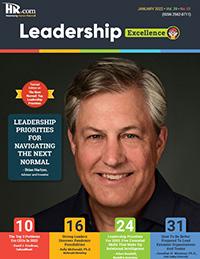
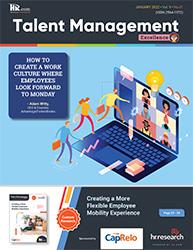

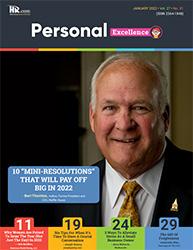


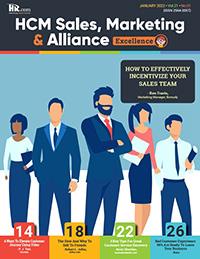
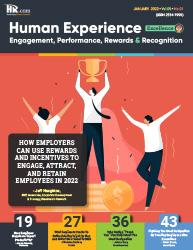

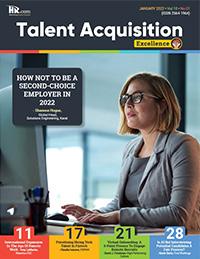


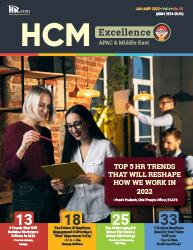
Like to submit an article? Use our online submission form or for more information go to www.hr.com/ExcellencePublications Publications 13 Targeted Publications to Reach Your Audience Informing, Educating, Enlightening and Assisting HR professionals in their personal and professional development, the Excellence series offers high-quality content through the publications!












































































